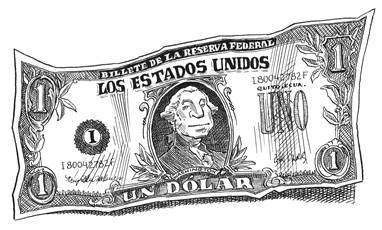- Economics
- Monetary Policy
In 1947, there were 76 independent countries. Today there are 193. Until recently, most countries had their own currencies. Hence, the expansion of the number of countries led to a proliferation of currencies.
Individual currencies are valued partly out of national pride and partly because they allow each country to pursue its own monetary policy. However, the benefit attributed to independent monetary policy has diminished as central banks have learned to value price stability over active macroeconomic stabilization. Moreover, the expansion of world trade has made it increasingly inconvenient for each country to have its own money. Therefore, the identification of currencies with countries has weakened, and the discussion has shifted toward one of desirable currency unions.
 |
|
Illustration by Taylor Jones for the Hoover Digest. |
Roughly 60 small economies have been members of currency unions for some time. Examples include the 15-member franc zone in Africa, the 7-member Eastern Caribbean Currency Area, Luxembourg using the Belgian franc, Panama using the U.S. dollar, and the West Bank and Gaza using the Israeli shekel. The most important example of a currency union, of course, is the 11 European countries that use the euro.
The dollar bloc, too, has been expanding. One attraction of dollarization is that sound monetary and exchange-rate policies no longer depend on the intelligence and discipline of domestic policymakers. Their monetary policy becomes essentially the one followed by the United States, and the exchange rate is fixed forever.
The latest country to tie the fate of its currency to the Federal Reserve is El Salvador, which recently said it would dollarize. As a positive sign of the times, this decision immediately received support from the U.S. Treasury and the International Monetary Fund. Currency boards–which are arrangements in which countries retain their own money but in which the central bank’s only function is to lock the value of the money to that of an anchor currency–exist in Hong Kong, Estonia, Bulgaria, and Lithuania.
Argentina adopted a currency board in 1991. The Argentine economy did well on average until 1999, but there is substantial controversy as to how much the current recession stems from this link to the strong U.S. dollar. I would argue that Argentina’s economic future would be jeopardized by elimination of the currency board and that a better course would involve full dollarization.
From a scientific standpoint, the most exciting recent development is the dollarization in Ecuador, a country that has been an economic and political disaster for some time. The situation appeared to brighten in 1998 with the election as president of Jamil Mahuad, who had been a successful reformer as mayor of Quito. However, he couldn’t gather the political support needed to solve problems with the public finances, subsidies on consumer goods, foreign debt, and the banking sector. When bank runs occurred in March 1999, he responded by freezing deposits. This action, apparently as dubious legally as it was economically, eventually earned Mahuad an arrest warrant after he was forced to move to the United States.
|
In country after country, the attraction of dollarization is that sound monetary and exchange-rate policies no longer depend on the intelligence and discipline of domestic policymakers. Monetary policy becomes essentially the one followed by the United States, and the exchange rate is fixed forever. |
Before that, Mahuad proposed to dollarize Ecuador, but his program was not part of a coherent economic package. He just suggested it because he became desperate to do something dramatic when his approval rating fell below 10 percent. Although the proposal led to a rise in his approval rating, it was not enough to save his presidency, and he was soon ousted in a bloodless coup. However, his vice president and successor, Gustavo Noboa, recognized the potential popularity of dollarization and therefore moved aggressively to make the U.S. dollar the currency of Ecuador. The transition is nearly complete. Fortunately for Ecuador, obtaining U.S. dollars to replace sucres has been aided by the high price of oil, Ecuador’s main export.
There is an ongoing debate on whether major monetary reforms, such as dollarization, can be successful without the preconditions of sound fiscal and banking practices. Ecuador is therefore interesting because none of these preconditions existed. In fact, these deficiencies were part of the crisis atmosphere that generated the political consensus for dollarization.
In other words, the lack of supposed preconditions explains why dollarization occurred in Ecuador in the first place. In contrast, El Salvador is in much better shape in overall economic policy, and the recently announced dollarization had been contemplated for many years. The crucial question for Ecuador is whether dollarization itself will help to cure problems such as fiscal imbalances and banking inadequacies. One temporary problem, caused by the sharpness of the devaluation in 1999, is a burst of inflation, but this should ease this year.
Thus far, dollarization seems to be serving in Ecuador as a foundation for the resolution of other economic problems. Progress has been made with international debtors, and some domestic reforms have been accomplished. My prediction is that dollarization will continue to help with these problems, although political impasses will sometimes occur. I also predict that other countries in Latin America will observe this success and will move–it is to be hoped more coherently than Ecuador–toward dollarization.







